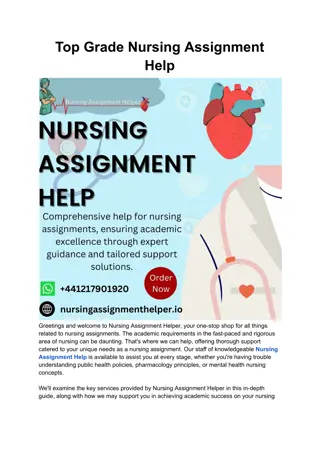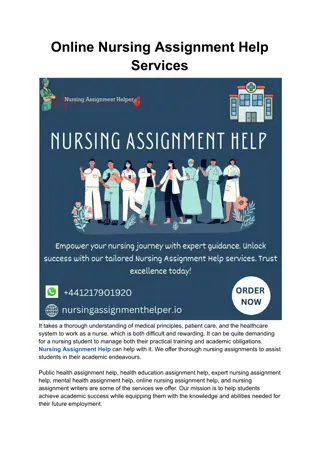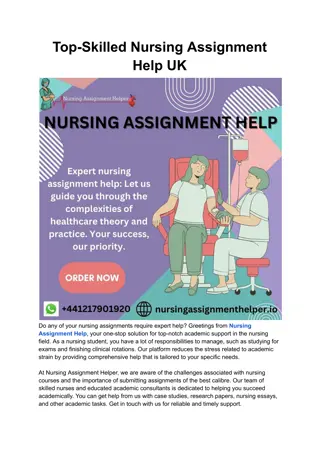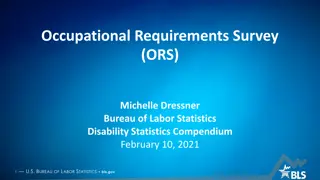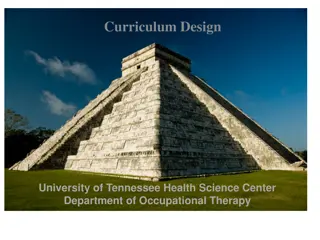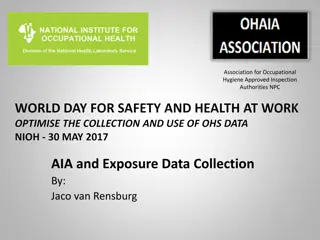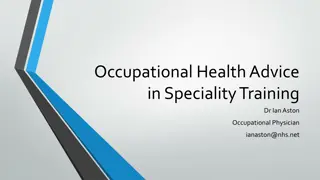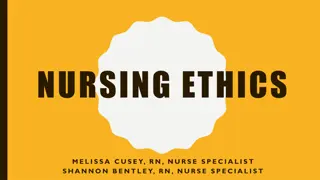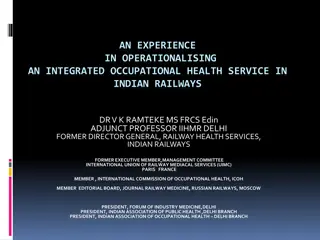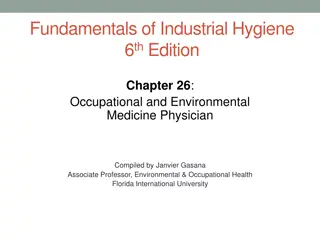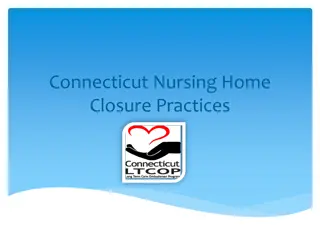Occupational Health Nursing: Roles and Responsibilities
Occupational Health Nursing involves providing health and safety programs and services to workers and communities, grounded in public health principles. It includes clinical care, case management, health hazard assessment, compliance with regulations, health promotion, and research. The practice's scope varies based on industry variables like company size, hazard profiles, and organizational climate. Employers face challenges like new regulations, environmental concerns, workforce health issues, and changing insurance trends.
Download Presentation

Please find below an Image/Link to download the presentation.
The content on the website is provided AS IS for your information and personal use only. It may not be sold, licensed, or shared on other websites without obtaining consent from the author. Download presentation by click this link. If you encounter any issues during the download, it is possible that the publisher has removed the file from their server.
E N D
Presentation Transcript
Fundamentals of Industrial Hygiene 6th Edition Chapter 27: The Occupational Health Nurse Compiled by Janvier Gasana Associate Professor, Environmental and Occupational Health Florida International University
Definition of the Occupational Health Nurse As of 2004, about 22,447 registered nurses provide care in occupational health settings Goal is to provide safe and healthy workplace for all, and to protect human resources. Occupational and environmental health nursing: Specialty practice that provides for and delivers health and safety programs and services to workers, worker populations and community groups. Occupational health nursing (OHN) is grounded in the public health principles of primary, secondary, and tertiary prevention
Scope of Practice Occupational health nursing services include: clinical care including assessment, diagnosis, management, and documentation of illness and injury case management health hazard assessment and surveillance of employee populations, workplaces, and community groups investigation, monitoring, and analysis of illness and injury episodes and trends, and methods to promote and protect employee health and safety compliance with laws, regulations, and standards management and administration of occupational and environmental health services health promotion and disease prevention strategies counselling, health education, and training programs research related to occupational and environmental health
Practice of Occupational Health Nursing Several models for service delivery, from on-site salaried personnel to off-site contractual arrangements Scope of occupational health services depends on following key industry variables: company size and demographics of workforce geographic distance to health care facility in community type of industry (manufacturing vs. service) hazard profile (review of OSHA 300 log, emergency response needs, potential exposures/trends in claims) risk management and health benefit philosophy of company economic resources self-insurance status for workers compensation and personal health care organizational climate, specifically regarding health, hazard communication, and value of prevention activities
OHN Staffing and Outcomes Some health issues employers face: new health and safety regulations hazards associated with new work processes new environmental concerns employment of temporary and contractual workers musculoskeletal complaints in aging workforce increase in obesity and diabetes in workforce changing health care insurance system
OHN Staffing and Outcomes (cont.) OHNs are well prepared to manage complex interactions between health and work, while valuing prevention agenda. Knowledge of key players in addition to knowledge of work process, allows for worksite interventions to improve work environment Majority of OHNs are employed by larger employers in manufacturing and health care sectors for smaller employers, OHN may be the only health care provider on site
OHN Role and Levels of Prevention OHN role requires knowledge, skills, and abilities in following competencies: clinical and primary care case management work force, workplace, and environmental issues regulatory/legislative issues management health promotion and disease prevention occupational and environmental health and safety education/training research professionalism
Programmatic Components Primary prevention pre-placement (post-offer) evaluations immunizations employee training wellness programs employee assistance programs Secondary prevention assessment and management of health complaints health/medical surveillance Tertiary prevention case management modified duty programs Programs commonly managed by OHNs workers compensation Americans with Disabilities Act recordkeeping blood-borne pathogens ergonomics Evaluating outcomes of OHN activities
Primary Prevention Pre-placement evaluation goal is to place workers in jobs based on physical capabilities and make reasonable accommodations, if needed, and stay in compliance with ADA Increasing immunization coverage for both adults and children to prevent vaccine-related diseases Healthy People 2020 goal More than 100 OSHA standards require employer to train employees in health and safety Employee Assistance Programs (EAPs) use both primary and secondary prevention methods to recognize, assess, treat, and refer employees with personal and mental health problems that impact job performance
Secondary Prevention Assessment and management of health complaints Employee commonly has interaction with OHN for health complaint (acute or chronic problem) Screening Tests aim for early detection of asymptomatic disease with goal that treatment can render improved outcome Health/medical surveillance Occupational health surveillance is the process of monitoring health status of worker populations to gather data about effects of workplace exposures and to use data to prevent illness or injury
Tertiary Prevention Case management = timely coordination of quality, evidenced-based health services with goal to decrease fragmentation of care, enhance client s quality of life, and to contain health care costs Timely return to work, in temporary transitional or modified duty assignments, is realistic outcome measure for case management program targeting both non-work- and work- related injuries and illnesses Advocating for safe transitional work a major role for OHN
Common Programs Managed Workers compensation Job-related injuries cost employers billions of dollars per year in direct workers compensation expenses: medical care costs temporary and permanent disability vocational rehabilitation medical-legal costs Indirect costs retraining replacement workers lost productivity workplace accommodation other preventive efforts Injured workers may sustain severe economic consequences from workplace injuries, specifically in lost earnings, pain and functional impairment, and decreased quality of life
Common Programs Managed (cont.) Americans with Disabilities Act About 43 million Americans have one or more physical or mental disabilities This population is targeted by ADA (Public Law No. 101336) ADA, signed into law in 1991, prohibits discrimination against people with disabilities in employment transportation public accommodation activities of state and local government telecommunication relay services
Common Programs Managed (cont.) OSHA Injury and Illness Recordkeeping Standard Maintenance of OSHA 300 logs Level of care and treatment provided to injured worker determines if case is recorded on OSHA 300 log First aid cases, as defined by OSHA, not recorded Recordable conditions include: every death, every occupational illness and injury involving medical treatment beyond first aid lost time work modification job transfer any loss of consciousness
Common Programs Managed (cont.) Blood-borne Pathogens Program OSHA Blood-borne Pathogens Standard, adopted in 1992, and revised in 2001, requires employers to establish exposure control plan for all employees who have occupational exposure to blood or other potentially infectious materials. It mandates Use of universal precautions and Provision of personal protective equipment by employer, Safe needle disposal containers, Self-sheathing needles, and Safer medical devices. Standard clarifies employer s responsibility to provide, at no cost to at-risk employees, hepatitis B vaccine series.
Common Programs Managed (cont.) Ergonomics OHNs often actively involved with ergonomic programs, both in office and manufacturing settings Practice of ergonomics involves work station evaluation, job analysis, and training Work-related musculoskeletal disorders are common in office, manufacturing, or hospital setting, and are predominant in positions with following risk factors: force repetition duration contact stressors awkward postures cold temperature vibration
Evaluating Outcomes Selected health outcome indicators for clinical care provided to injured workers in occupational setting may include: Access to care: Initial treatment for nonemergency work-related conditions will be delivered within 24 hours after injury is reported. Patient satisfaction: On a satisfaction survey, 85% of injured workers identified the OHN as very to extremely helpful in answering questions about workers compensation system. Primary prevention: High-risk health care workers will have documentation in their pre-placement record of hepatitis B vaccination offer/immunity. Secondary prevention: Occupational health history is documented in 90% of those medical records of employees with occupational injury; or chart documentation of ergonomic evaluation is in place within 1 week of diagnosis of work-related upper extremity complaint. Tertiary prevention: Sustained return to work, without re-injury, for 90 days after release to return to work; or litigated cases decreased to five percent after OHN case management intervention.
Evaluating Outcomes (cont.) Organizational outcomes include economic indicators in addition to productivity metrics. Selected organizational/economic indicators for occupational health services may include injury experience corrective action productivity as measured by Stanford presenteeism scale and/or the Work Limitations Questionnaire sickness absence measures worker engagement/job satisfaction measures








